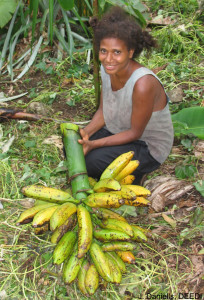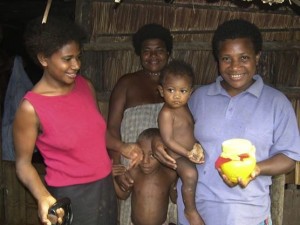- The Global Fossil Record. Visualized. Not agricultural, but couldn’t resist it.
- Malnutrition? It’s the culture, stupid.
- Check out the world’s largest chickpea drought trial.
- Overfishing the Amazon.
- Ah, so that’s how wheat did it!
- Food aid can support sustainable livelihoods too.
- Soon, most crop production will go to feed China’s pigs. And you’ll be able to follow that on FAOStat’s interactive thingie on agricultural tradeflows.
- But it can’t possibly be good for sustainable diets, can it?
- New book on fermentation. Never enough of those.
Remembering Dorothy Tamasia, barefoot banana curator of the Solomon Islands
Some bad news from Tony Jansen, via Facebook. He has kindly given us permission to reproduce his post here. This comes after more sad news from the Pacific just a few weeks ago.
 I’m very sad to hear the tragic news that my very good friend Dorothy Tamasia has died. I dont know the hows or whats, only that she was too young. She was the true embodiment of the barefoot curator and lived out her life in very basic conditions with her people in the highlands of central Makira and passionately collected, protected and shared across her island and throughout the Solomon Islands over 108 varieties of bananas that she took part in collecting with Kastom Gaden Association. She was trained in morphological descriptors and management of germplasm collections despite having little formal education. Her work in documenting and maintaining her banana collection led to Solomon Islands being recognised as holding one of the largest remaining and least documented collection of banana diversity in the world – and she was a leading figure in a revival in banana diversity and its cultural connections in Makira through diversity fairs and other events.
I’m very sad to hear the tragic news that my very good friend Dorothy Tamasia has died. I dont know the hows or whats, only that she was too young. She was the true embodiment of the barefoot curator and lived out her life in very basic conditions with her people in the highlands of central Makira and passionately collected, protected and shared across her island and throughout the Solomon Islands over 108 varieties of bananas that she took part in collecting with Kastom Gaden Association. She was trained in morphological descriptors and management of germplasm collections despite having little formal education. Her work in documenting and maintaining her banana collection led to Solomon Islands being recognised as holding one of the largest remaining and least documented collection of banana diversity in the world – and she was a leading figure in a revival in banana diversity and its cultural connections in Makira through diversity fairs and other events.
Banana is the staple food in Makira. Dorothy was a hero for conservation in use of plant genetic resources and she dedicated much of her too short life to that purpose. She took part in pioneering work to test and promote high vitamin A fei banana varieties. A poster from that work can be seen here and she was part of banana diversity work supported variously by ACIAR, the SPC Centre for Pacific Crops and Trees (CePaCT) and Seed Savers Network.
 I last saw her in late 2011 after making the 4 hour walk to her village from the coast — which has no roads and is one of the most remote parts of a remote country. She was happy, and had recently started a bush early-childhood pre-school in a leaf house in a remote riverside location where she lived on her own with her children. The room was full of brightly coloured creations from nearby village children who came to her school — and surrounded by her bananas and her cacao farm. She was excited to be studying early childhood education. She was also busy duplicating, on her own, the banana collection she had maintained for almost a decade — back breaking work with no reward other than the custodianship that she treasured. She had a deep grasp of the issues including the controversy around crop genetic resources. She chose to keep above all of it and just continue her humble work that she knew was the right thing and a useful thing to do.
I last saw her in late 2011 after making the 4 hour walk to her village from the coast — which has no roads and is one of the most remote parts of a remote country. She was happy, and had recently started a bush early-childhood pre-school in a leaf house in a remote riverside location where she lived on her own with her children. The room was full of brightly coloured creations from nearby village children who came to her school — and surrounded by her bananas and her cacao farm. She was excited to be studying early childhood education. She was also busy duplicating, on her own, the banana collection she had maintained for almost a decade — back breaking work with no reward other than the custodianship that she treasured. She had a deep grasp of the issues including the controversy around crop genetic resources. She chose to keep above all of it and just continue her humble work that she knew was the right thing and a useful thing to do.
Dorothy was a beautiful person and a kind hearted and generous soul. I hope that in her death her life work and commitment to the Solomon Islands indigenous plant genetic resources and to food security for her people will be acknowledged and that the collections she had maintained will be supported to continue.
Nibbles: Restoring forests, Sampling strategies, Breadfruit history, Wheat & CC, Pacific fisheries, Sustainable food experts, CG talkfest, Irish & potatoes, Diet costs, ITPGRFA projects, Poaching & medicine, Coca alternatives, Ethiopian agroforestry, Mutation breeding, Gaza greens
- Genetic considerations in ecosystem restoration using native tree species. No excuse for getting it wrong now.
- “Careful tailoring of seed collections to specific species and situations critical to preserving plant diversity.” No excuse for getting it wrong now.
- Breadfruit makes The Paris Review.
- Got any ideas on protecting wheat from heat and drought?
- Where will Pacific Islanders get their protein from if all the fish go?
- International Panel of Experts on Sustainable Food Systems set up. Rejoice. Maybe they’ll be invited to the CGIAR’s Development Dialogues.
- The Irish know a thing or two about sustainable food systems.
- Yeah but how much does a decent diet cost anyway?
- An overview of the Seed Treaty’s projects on climate change adaptation.
- Poaching in Kenya driven by demand for dodgy traditional medicine? And finding an alternative for Peru’s traditional medicine of choice.
- What has agroforestry ever done for us?
- You say conventional I say mutation.
- The leafy greens of Gaza.
Brainfood: Luffa diversity, Pyrennean landraces, Sorghum diversity, Eucalypt diversity, French wheat, Genomic breeding, Hotspots, Protected areas, Apple diversity
- Population structure and diversity in cultivated and wild Luffa species. Luffa hermaphrodita is the closest wild species.
- Factors Enhancing Landrace in Situ Conservation in Home Gardens and Fields in Vall de Gósol, Catalan Pyrenees, Iberian Peninsula. It’s not just about landrace performance.
- Sorghum Genetic Resources: Conservation and Diversity Assessment for Enhanced Utilization in Sorghum Improvement. 236,000 accessions, 38,000 at ICRISAT alone, of which 3 have proved useful. Wait, what?
- Genetic Diversity in Eucalypts. It’s high, and needs to be used.
- Explaining the decrease in the genetic diversity of wheat in France over the 20th century. Because breeding.
- Animal-breeding schemes using genomic information need breeding plans designed to maximise long-term genetic gains. You can’t just wing it.
- Remaining natural vegetation in the global biodiversity hotspots. 15%, and fragmented.
- Targeting Global Protected Area Expansion for Imperiled Biodiversity. Increasing protected area coverage to Aichi targets would do little to achieve threatened species coverage in situ, at least for vertebrates.
- Phenotypic evaluation and characterization of a collection of Malus species. German apple collection characterized the old school way, and none the worse for that.
Nibbles: Sorghum research, Alternative millet, IRRI genebank genomics, Cattle genomes, CIAT genebank, Rainforest genebank, Saving seeds, Millet in India, Varied diets, Cheese rind microbes, Fermentation, Artisanal hooch, Truffle oil, Coconut water, Fancy carrots, Edible insects, Farming tuna, Saving cetaceans, Fancy tomato database
- What must be done about sorghum in Africa, by someone who should know because they worked at ICRISAT, which has a sorghum genebank.
- ICRISAT also has pearl millet genebanks — in India and Africa. So when did pearl millet become “alternative” in India? Well, at least it’s not on this list of “indigenous foods.”
- 3000 rice genomes (from the IRRI genebank), and 1000 bull genomes. Brave new world.
- The CIAT genebank makes the news, and not a genome in sight.
- An in situ forest genebank deep in the heart of Sabah.
- And you can bet they’re all saving seeds the right way. But there’s always a webinar if not. Or this.
- Micronutrients? It’s the food system, stupid. Yes, indeedy. And there’s even a webinar about it.
- The fascinating microbial system of cheese rinds.
- Sauerkraut has a pretty fascinating microbial system too, I bet.
- Artisanal whiskey is a thing? Isn’t it, basically, moonshine?
- Truffle oil is a scam. Damn.
- Coconut water tries not to seem a scam.
- Heifer Farm shows off its weird carrots. Yeah, they’re more than just about livestock at Heifer.
- Though that doesn’t include insects, I don’t think. Yes, insects.
- Or bluefin tuna. Or the vaquita. But enough of that.
- Plenty of weird tomatoes on this great wiki I came across.